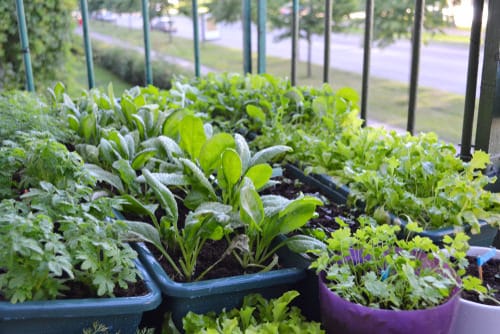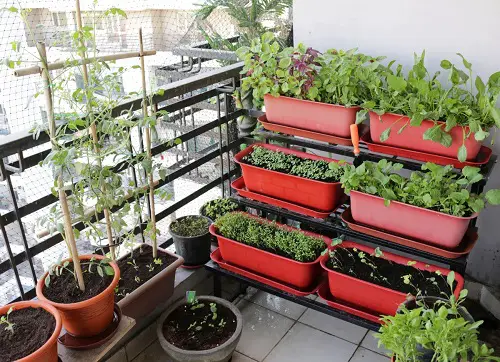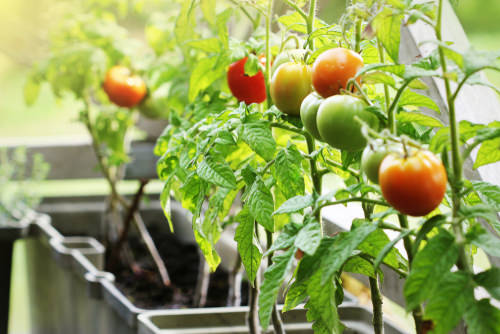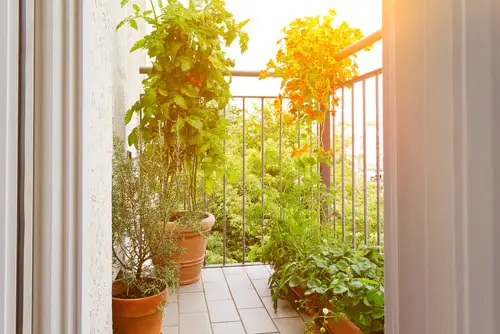Grow a Balcony Vegetable Garden in your urban space by using the information in our guide on Growing Vegetables on a Balcony!
 Growing vegetables on a balcony is an apt idea for city dwellers who do not have their own garden. This way, you can grow your own fresh and organic vegetables. Here are all the details on How to Start a Balcony Vegetable Garden!
Growing vegetables on a balcony is an apt idea for city dwellers who do not have their own garden. This way, you can grow your own fresh and organic vegetables. Here are all the details on How to Start a Balcony Vegetable Garden!
Have a look at the vegetables you can harvest indoors year-round here
Best Vegetables for Balcony Garden
Vegetables that don’t require a lot of space are ideal for growing on the balcony. Tomatoes and peppers are, without a doubt, the first ones you need to consider as they are the easiest to grow.
You can also start with climbing vegetables like beans, cucumbers, peas, and Malabar spinach as they all grow vertically and take little space. Check out our list of vining vegetables here!
Pro Tip: If you’ve got some big and medium-size pots, you can plant zucchini, okra, eggplant, and melons.
What Else Can You Grow on a Balcony?

In small pots, you can grow leafy greens like lettuce, spinach, arugula, mustard green, chard, endive leaf, and some exotic ones like Chinese cabbage, fenugreek, and bok-choy, as well as some easy root vegetables like radish, beets, carrot, ginger, and potato.
When it comes to easy edibles that don’t take space—you can’t miss green onions and garlic greens for your salads, soups, stews, omelets, noodles, and various meat and egg dishes.
While growing vegetables on the balcony, plant some companion herbs with them. Go with the commonly used herbs—parsley, chives, cilantro, mint, rosemary, or basil. Their combination enhances the taste of vegetables, and you will also get a fresh supply of herbs.
Growing Vegetables on a Balcony—Step by Step

1. Location
The number one factor determining what you can grow and what you can not is your location—the direction of your balcony garden and how much sunlight it receives. The sunnier, the better!
If it is a South or West-facing balcony, you’ll have sunshine almost all day, which means you can grow anything. An East facing balcony receives sunlight in the morning, which is sufficient for most greens, herbs, and root vegetables.
On the contrary, a North-facing balcony usually remains shady throughout the year, and it isn’t easy to grow vegetables in the shade. However, you can still try lettuce, parsley, peas, cilantro, fenugreek, green onions, bok choy, and mustard greens.
2. Pots for Growing Vegetables on the Balcony
Before purchasing pots for your vegetable balcony garden, you must consider whether you want to grow vegetables for ornamental or usability purposes. If usability is more important, simply select containers, propagation trays, and window boxes where many plants can grow together.
If you are concerned about the looks of your balcony vegetable garden, then choose colorful pots, decorative barrels, urns, and modern designer planters.
Keep in mind that the size of the pot must match the pace of growth and requirements of the plants you’re growing.
You can grow peppers, eggplants, peas, and cherry tomatoes in a 3-5 gallon size container. Large containers can be used for tall tomato varieties and beans. Seedlings of vegetable plants can be grown in a seed tray or small container to save space. Later they need to be transplanted in bigger pots.
Railing and vertical planters are also a great choice to utilize the limited space on a balcony. You can grow salad greens on a tower planter and hang small pots on the railings to grow herbs.
3. Soil for Planting Balcony Vegetable Garden
Vegetables grown in pots require loose, well-drained, fertile, and nutrient-rich soil. You can buy a commercial potting mix for this. If you want to prepare it yourself, check out our guide here.
In addition, incorporate a slow-release fertilizer or well-rotted manure or compost in your soil. You can add hydrogel crystals too if your balcony is windy and sunny. Hydrogel crystals absorb the excess water and keep it for later supply to the plant’s root directly.
If possible, do soil testing at home to identify the pH value of the soil you’re using. Generally, vegetables grow in slightly acidic to neutral soil (6-7 pH). Once you find your soil type (alkaline or acidic), amend it according to your growing plant.
4. Preparing Seedlings
Vegetable seeds can be sown on a seed tray. Transplant them once the top two leaves have developed. Some vegetables that do not transplant well are better germinated in separate pots.
Vegetables such as gourds, melons, turnips, and squashes do not transplant well and suffer damage when moved. Therefore, you must plant them directly at the preferred location or be extra careful when handling their seedlings.
If you do not want to sow seeds, purchase vegetable transplants from a nursery. Buy plants that are healthy and do not have any pests or diseases. Also, don’t forget to check out the most important seed starting tips here.
5. Planting

Seedlings are better transplanted on cloudy days in moist soil. This helps the young plants in establishing well. On sunny days, planting should be done in late afternoons or evenings. Before transplanting the seedlings, water them abundantly, this prevents the shock and breakdown of soil around the roots.
Seeding should be planted at the proper depth. Tomatoes can be planted deeper, covering up to the first set of leaves. This stimulates the adventitious roots, hence strengthening the plant. However, lettuce planted too deep can not develop heads. Similarly, celery, too, does not appreciate deep planting.
Pro Tip: Feed the plants one tablespoon Epsom salt mixed in one gallon of water after planting to avoid transplanting shock.
How to Care for Balcony Vegetables?

- It is crucial to water the plants in the right way. Avoid these common mistakes.
- Watering the plants at night invites fungal diseases, making them vulnerable to pest infestation, so it is best to water your plants in the morning.
- When the vegetables adapt to the microclimate of your balcony, their only requirement is watering, fertilization, and occasional trimming of dead and damaged leaves and removing suckers if you’re growing tomatoes and eggplants.
- Generally, you should feed your plants every 2-4 weeks with balanced liquid fertilizer or side-dress the vegetables and herbs with compost or well-rotted manure twice during the growing season.
- To save your plants from pests, keep removing them by handpicking or spraying water jets and growing plants that deter pests.
- In the case of severe pest infestation and diseases, use organic pesticide, homemade insecticidal soap, and neem oil.
- Using chemical pesticides and fungicides should be the last option if you prefer organic gardening.





What kind of fertilizer we should use for Guova,lemon,mango plant at my roof top garden.
Guava tree in pot can be fertilized with 6-6-6 fertilizer every month according to the product instruction. Guava also needs magnesium, fertilize it with one tablespoon of Epsom salt mixed in one gallon water every month or so.
For Lemon, read this post.
And mango, read here.
I am following this site for quite sometime. It is very informative in gardening. I am plant lover. I have many plants at my residence including one Brahamakamal. I am very passionate to this plant.. Now I intend to shift to my new home at Jaipur. I am planning to set up rooftop terrace garden in my house but I am very tensed if Jaipur weather will suit my terrace garden. Can you suggest me something in this regard.